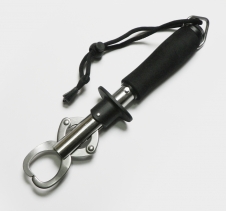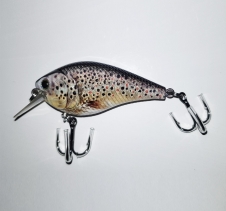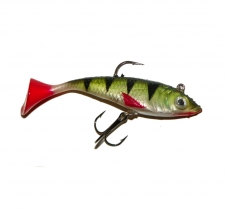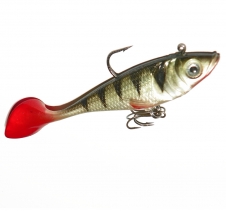Visit Our Online Store! $7 AusPost Parcel Post Delivery FREE Postage for orders $45 and over!
* Shipping rates above apply to Australian Customers only
Jungle Perch Fishing in Queensland.
Introduction to the Jungle Perch, habitat, behaviour, popular baits, lures and hook sizes.
The Jungle Perch get their name from their habitat, they are found in tropical mountain streams north of Townsville in Queensland. 30 years ago they were very common throughout all east coast Queensland streams, however mostly due to changes in their natural habitat further south, they are now only found in small pockets in the north.
The Jungle Perch is also found within New Guinea. Originally the scientific name was referred to as Dules rupestrist haswelli, the name has since changed and the common scientific name of this species is now Kuhlia rupestris.
This fish is commonly brown on top with the colour becomming lighter lower down, with dark spots across the head and body. The tail has 2 small dark blotches top and bottom. Jungle Perch commonly reside in freshwater, where they have an exceptional ability to distribute themselves all the way to the top of mountain streams, except of course those which are divided by large waterfalls. Breeding however takes place within salt water estuaries along the coast.
Fishing tactics are similar to those used for Australian Bass, and catching them on light tackle can be very enjoyable. The most popular baits to use are young yabbies which are collected on site at the river you are fishing in, live earthworms and grasshoppers are also very successful baits. Recommended hook sizes are a #4 hook for yabbies or worms, or a 1/0 hook should you be using grasshoppers / locusts.
The jungle perch can also be landed on regular spin lures (such as those used for trout / redfin), diving hard body lures and small surface poppers.
These fish are notoriously shy of humans, and if they catch a glimpse of you on the shoreline they will shy away from taking any bait or lure presented to them following this. It is extremely important when fishing for jungle perch to keep yourself out of sight of the fish, such as sitting or casting behind shrubs along the shoreline. If bait fishing keeping a fair distance away from the water is best, with a few trees between you to keep visibility minimal to none should a jungle perch be scoping for food.
As an important native sporting fish and the fact their natural range has declined heavily in recent decades, in addition to following the fisheries departments mandated bag limit of 1 fish under 35cm (accurate as of August, 2014.), it is best to strongly consider fishing for them using lures to prevent harming the fish during catch and release efforts, bait is often swallowed by jungle perch which makes it extremely difficult or sometimes impossible to remove the hook safely, releasing these fish with a hook still in their throat gives them a much lower chance of survival.
Using artificial lures makes removing hooks much easier, as the method of lure fishing gives fish little to no time to swallow a lure. Should you however decide to use bait and it is not possible to remove the hook without causing the fish harm, then release with the hook may unfortunately be the only option.
The Jungle Perch is also found within New Guinea. Originally the scientific name was referred to as Dules rupestrist haswelli, the name has since changed and the common scientific name of this species is now Kuhlia rupestris.
This fish is commonly brown on top with the colour becomming lighter lower down, with dark spots across the head and body. The tail has 2 small dark blotches top and bottom. Jungle Perch commonly reside in freshwater, where they have an exceptional ability to distribute themselves all the way to the top of mountain streams, except of course those which are divided by large waterfalls. Breeding however takes place within salt water estuaries along the coast.
Fishing tactics are similar to those used for Australian Bass, and catching them on light tackle can be very enjoyable. The most popular baits to use are young yabbies which are collected on site at the river you are fishing in, live earthworms and grasshoppers are also very successful baits. Recommended hook sizes are a #4 hook for yabbies or worms, or a 1/0 hook should you be using grasshoppers / locusts.
The jungle perch can also be landed on regular spin lures (such as those used for trout / redfin), diving hard body lures and small surface poppers.
These fish are notoriously shy of humans, and if they catch a glimpse of you on the shoreline they will shy away from taking any bait or lure presented to them following this. It is extremely important when fishing for jungle perch to keep yourself out of sight of the fish, such as sitting or casting behind shrubs along the shoreline. If bait fishing keeping a fair distance away from the water is best, with a few trees between you to keep visibility minimal to none should a jungle perch be scoping for food.
As an important native sporting fish and the fact their natural range has declined heavily in recent decades, in addition to following the fisheries departments mandated bag limit of 1 fish under 35cm (accurate as of August, 2014.), it is best to strongly consider fishing for them using lures to prevent harming the fish during catch and release efforts, bait is often swallowed by jungle perch which makes it extremely difficult or sometimes impossible to remove the hook safely, releasing these fish with a hook still in their throat gives them a much lower chance of survival.
Using artificial lures makes removing hooks much easier, as the method of lure fishing gives fish little to no time to swallow a lure. Should you however decide to use bait and it is not possible to remove the hook without causing the fish harm, then release with the hook may unfortunately be the only option.
Follow us on twitter: @FishTackleLures or Google Plus: +FishingTackleLuresAU
View more articles in our Australian Fishing Guide.
Enter your email address below to be updated on new fishing articles, fishing lures and special offers:
We will only email once every two to four weeks at the most, usually every 2 months.
POPULAR PRODUCTS IN OUR ONLINE STORE





